Revell 1/72 Panzer III M | 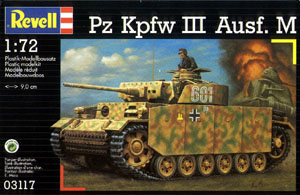 | History The Panzerkampfivagen III (PzKpfw III), along with the contemporary PzKpfw W, represented a major step forward in the development of the modern main battle tank. These vehicles were the first tanks designed for use in integrated armor attacks, like those envisioned by Guderian and other farsighted leaders who understood the potential of mobile warfare. Design contracts for the PzKpfw III and W were issued by the German Ordnance Department to the firms of MAN, Daimler-Benz, Rheinmetall-Borsig, and Krupp in 1935. The lighter vehicle, in the 15 ton class, was originally designated the 37MM GeschatzPanzerwagen, and given the number Vs Kfz 619 (Trial Vehicle 619). Later the designation was changed to Zugfahrerwagen (platoon leader's vehicle). Mter evaluating designs from both Krupp and Daimler-Benz, the Ordnance Department awarded a development contract to Daimler-Benz for production of a series ofprototype vehicles under the designation Panzerkampfivagen III with production of the first prototypes beginning in 1937. A major design feature of the Ordnance Department specification was the provision for armor protection around the entire vehicle. Since the PzKpfw III was intended to be used in the forward element of an armored assault force, it had to be protected from enemy fire from all directions. In contrast, the heavier PzKpfw W, intended as a fire support tank, was more heavily armored in the front than in the rear. Daimler-Benz produced four developmental prototypes of the PzKpfw III. Tbe l5MM armor of these vehicles was designed to protect the tank from standard anti-tank rifles then in use. Armament was specified to be a 37MM KwK cannon with a barrel length of 46.5 calibers. Secondary armament consisted of two coaxial 7.92MM MG 34 machine guns in the mantlet, and a third MG 34 in an armored ball mount in the superstructure front plate. The PzKpfw III had a crew of five: commander, gunner, loader, driver, and radio operator/bow gunner. Early vehicles were powered by a 230 hp Maybach V-12 gasoline engine mounted in the rear of the hull coupled with a five speed gearbox and final drive unit installed in the front of the hull. The engine drive shaft ran under the vehicle floor. This basic layout of vehicle and crew set the standard for future tank development for more than a decade. Many other tanks of the mid-1930s had two or three-man crews, which often overworked the crew members. Additionally, both the PzKpfw III and W were equipped with an intercommunications system which linked the entire crew, allowing quick and accurate orders to be passed even in the noise and confusion of combat. 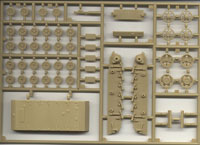 The Kit The Kit
The Revell 1/72nd Panzer III M consists of 181 injected molded pieces, which includes link and length track. The molding quality is very high and this is the best small-scale injected kit I have seen to date. Decals consist of two schemes, both on the Eastern Front – the first of the 6. Pz. Division, Belgorod, and the second of the 2. Pz. Division (Wein), Khifzky (descriptions taken from the instruction sheet). As I mentioned, the molding quality is the highest I have ever seen on an injected kit. No flash, nothing “extra” to worry about. Construction naturally starts with gluing 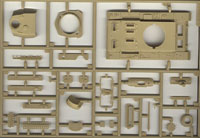 the lower hull sides to the lower hull, and then continues with gluing the wheels together. Since all wheels were two-piece on the original, Revell provides these as two pieces, unlike some of the early ESCI kits that supplied one “wheel” for each place. Once all wheels are glued together they’re added to the lower hull assembly. It is definitely best to paint the wheels before gluing them to the lower hull, as the return rollers and main wheels were rubber-rimmed on the real thing. the lower hull sides to the lower hull, and then continues with gluing the wheels together. Since all wheels were two-piece on the original, Revell provides these as two pieces, unlike some of the early ESCI kits that supplied one “wheel” for each place. Once all wheels are glued together they’re added to the lower hull assembly. It is definitely best to paint the wheels before gluing them to the lower hull, as the return rollers and main wheels were rubber-rimmed on the real thing. From there one adds the upper hull to the lower hull and adds all the detail “bits” to the upper hull. Personally I would rather add all the bits to the upper hull first, paint 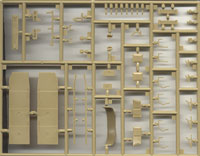 it and the lower hull separate and attach the two together later. Most of the upper hulls “pieces” are separate, minus – unfortunately – most of the pioneer equipment. It is my belief that all pieces that are normally separate on the upper hull should be so on the model. While the detailing is superb enough on this kit that the only thing you’ll have to do to pop out the detail is a good paint wash, it still would be nice to have it all separate. it and the lower hull separate and attach the two together later. Most of the upper hulls “pieces” are separate, minus – unfortunately – most of the pioneer equipment. It is my belief that all pieces that are normally separate on the upper hull should be so on the model. While the detailing is superb enough on this kit that the only thing you’ll have to do to pop out the detail is a good paint wash, it still would be nice to have it all separate. From here the two most difficult aspects of the kit are accomplished. That includes the gluing of the link and length track to the wheels, as well as the mounting of the side skirts and mounting hardware. 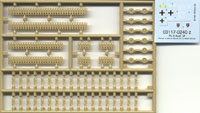 Next up is the construction of the turret, and having the top doors as “open able” pieces will please those who like to open up parts of their tanks. After the turret is glued all together, adding it to the hull assembly finishes the construction. Next up is the construction of the turret, and having the top doors as “open able” pieces will please those who like to open up parts of their tanks. After the turret is glued all together, adding it to the hull assembly finishes the construction.
Conclusion Overall this is a superb model, one I would think of building out of the box (which I normally never do). The detailing is first rate and it’s of a subject sorely neglected by the “mainstream” in the past. I personally hope that not only will Revell release the earlier versions of this particular tank, but also that someone – maybe Revell – release the Stug III and the SU-76i. Highly recommended. | 

 



|
